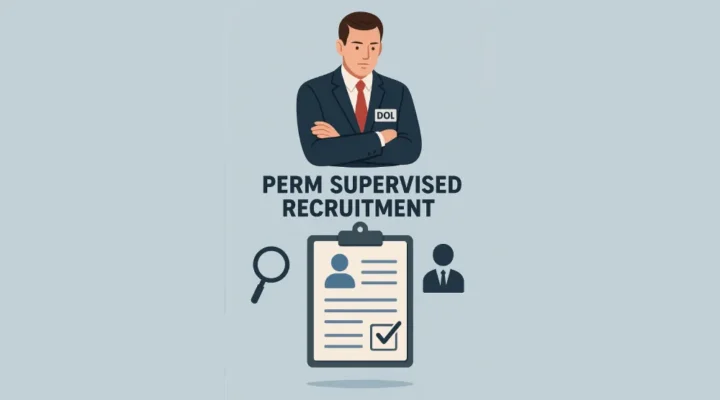For many employment-based green cards, a U.S. employer must undergo the PERM recruitment process that is required before submitting an ETA-9089 PERM labor certification application. However, if any concerns arise regarding the recruitment efforts in a Department of Labor audit, the U.S. Department of Labor’s Certifying Officer (CO) may enforce PERM supervised recruitment for your employer. If this happens, here is what to expect.
What is PERM Supervised Recruitment?
PERM Supervised recruitment requires your employer to undergo recruitment efforts under the direct supervision of the Department of Labor Certifying Officer (CO).
In this case, the CO provides specific instructions on the recruitment steps the employer must take. Moreover, the employer must submit all resumes and applications received directly to the CO for review.
The Regulatory Basis for Supervised Recruitment
The procedures for PERM supervised recruitment are outlined by the Department of Labor in the Code of Federal Regulations at 20 CFR § 656.21. This regulation grants the Certifying Officer (CO) the authority to mandate and direct this process when there are doubts about the integrity of an employer’s labor market test. Our guide breaks down this complex legal process into clear, actionable steps.”
Why Does PERM Supervised Recruitment Occur?
PERM Supervised Recruitment occurs if there’s been an unsatisfactory audit response or if the U.S. employer fails to respond appropriately to the audit letter sent.
This directive requires the employer to conduct an entirely new recruitment campaign for the current application. Separately, in cases involving significant non-compliance, the DOL may also mandate supervised recruitment for an employer’s future PERM applications.
How to Avoid PERM Supervised Recruitment
To avoid PERM supervised recruitment, you must prepare for the high likelihood of a PERM audit. An unsuccessful response to a PERM audit leads to supervised recruitment.
This is achieved by maintaining a thorough, organized, and complete audit file from the very beginning of the process, including:
- All advertisements posted during the recruitment period, including tear sheets, printouts, and screenshots.
- All applicants who applied for the position, along with their resumes or applications.
- Appropriate reasons for the rejection of each U.S. applicant, supported by detailed interview notes.
Since any PERM application can be selected for a random or targeted audit, having this file ready is not optional.
If you receive an audit letter, you can use this detailed record to prove that all regulations were followed and the labor market was rigorously tested. A successful audit response is what ultimately prevents a supervised recruitment order.
PERM Supervised Recruitment Process
The process begins after a PERM application has been filed and the Certifying Officer (CO) determines, usually after an audit, that the employer’s initial recruitment was deficient.
Step 1: The Order is Issued
The Certifying Officer sends “Remand Letter” to the employer and their attorney ordering supervised recruitment. The letter outlines the specific recruitment steps the employer must take, specifying types of advertisements required and where they must be published.
Step 2: Employer Prepares Ad Content
The employer, typically with the support of a lawyer, drafts the text for the new advertisements based exactly on the CO’s instructions. The ad must contain specific language, often directing applicants to send their resumes directly to the DOL, not to the employer.
This is usually required within 30 days of receiving the order, but the employer should follow the specific deadline stated in the letter. The regulations do allow the CO to grant a one-time, 30-day extension for this specific step.
Step 3: Ad Content is Submitted to the CO for Approval
The employer sends the drafted ad text to the Certifying Officer for review. The employer cannot proceed with recruitment/ads until the CO has provided written approval.
The CO may require revisions before giving the final sign-off. They will not approve an ad containing questionable requirements until the employer has satisfactorily proven they are essential for the job.
Step 4: Placing the Approved Advertisements
Once the ad content is approved, the employer pays for and places the advertisements in the specific media outlets within the timeframe outlined by the CO. The recruitment period is at least 60 days.
The employer must place all required ads during this time.The employer must retain proof of publication (e.g., newspaper tear sheets, invoices).
Step 5: Applicants Respond Directly to the DOL
In supervised recruitment, interested U.S. workers send their resumes and applications directly to the Certifying Officer, not the employer. This ensures the DOL can verify every applicant before the employer does.
Step 6: The CO Screens and Forwards Resumes
The Certifying Officer and their staff perform an initial screening of the resumes received. They filter out any applicants who are clearly unqualified and forward the resumes of all potentially qualified U.S. workers to the employer for review and consideration.
Step 7: Employer Reviews, Contacts, and Interviews Candidates
The employer must review each resume forwarded by the CO and contact each candidate to conduct interviews. The employer cannot ignore any referred candidate.
Step 8: Employer Submits a Detailed Recruitment Report
After the review and interview period is complete, the employer must prepare and submit a comprehensive recruitment report to the Certifying Officer. This report must include:
- Evidence that the approved ads ran as directed.
- The name of every applicant referred by the CO.
- Documentation of efforts made to contact each applicant.
- For each applicant not hired, the employer must provide a detailed, lawful, and job-related reason for their rejection, supported by interview notes and a comparison of the applicant’s qualifications to the minimum job requirements.
This report is due within 30 days from the date the CO sends the final batch of resumes to the employer. This 30-day window includes the time needed to contact, interview, and evaluate all candidates.
Step 9: Final Decision by the Certifying Officer
The Certifying Officer reviews the employer’s recruitment report in its entirety.
- Approval: If the CO is satisfied that the employer followed all instructions, acted in good faith, and provided lawful reasons for rejecting all U.S. applicants, the PERM labor certification may be approved.
- Denial: If the CO finds that the employer failed to follow instructions, did not act in good faith, or improperly rejected a qualified U.S. worker, the PERM application will be denied.
The entire supervised recruitment process can easily add 12+ months to the PERM processing timeline. It is a costly, time-consuming, and high-stakes procedure that requires absolute compliance with the DOL’s directives.
PERM supervised recruitment is a remedial measure designed to rectify an insufficient labor market test. Success is dependent on three principles: absolute compliance with the Certifying Officer’s directives, thorough documentation of every step, and adherence to regulatory deadlines.
While daunting, this process is navigable with precise execution and expert guidance. The stakes are high, as any misstep will result in a denial of the labor certification.
PERM Supervised Recruitment FAQ
Below are some of the most common PERM supervised recruitment questions and answers. Be aware that this is general information and may or may not apply to your case.
How long does the PERM process take?
The PERM process takes ~16 months to process. Audits and supervised recruitments can signficantly delay the process.
What happens if the final supervised recruitment report is submitted late?
The 30-day deadline to submit the final report is a strict, regulatory deadline with no extensions. If the report is submitted even one day late, the application will be denied.
Is there a way to know if my employer will be selected for PERM supervised recruitment?
The short answer is no. Just like the auditing system, supervised recruitment is designed to keep U.S. employers from taking advantage of the immigration system and removing job opportunities from qualified U.S. workers.
However, there has been evidence to show that the DOL may target areas that have a higher rate of layoffs, as well as employers that are related to industries such as the automotive or technology industries.
What is the PERM supervised recruitment success rate typically?
It’s hard to specify an exact number because that information is not made readily available. We can say that VisaNation Law Group’s lawyers have in-depth experience handling these sorts of cases.
What is the difference between PERM supervised recruitment and a PERM audit?
An audit is a review of recruitment that has already happened, while supervised recruitment is an order to conduct a brand-new recruitment campaign under the direct oversight of the Department of Labor (DOL).
The simplest way to understand the distinction is to think of an audit as a “show me your work” request and supervised recruitment as a “do it all over again under my watch” command
Will I need to restart the recruitment process if I am selected for supervised recruitment?
Yes. If you are selected for supervised recruitment, you must completely restart the entire recruitment process from the beginning.
Is the PERM required for all green card cases?
No. The PERM labor certification is a required first step for most employment-based green card categories, specifically the standard EB-2 and EB-3 petitions.
However, there are several key exceptions. The PERM process is not required for EB-1 (Extraordinary Ability, etc.), EB-4 (Special Immigrants), and EB-5 (Investors). A major exception also exists within the EB-2 category for those who qualify for a National Interest Waiver (NIW).
RELATED PERM Supervised Recruitment TOPICS
- PERM Labor Certification
- PERM Labor Certification Audit
- PERM Denial After Audit
- PERM Prevailing Wages
- PERM Prevailing Wage Determination FAQ
- PERM Recruitment
- PERM Advertising Requirements








